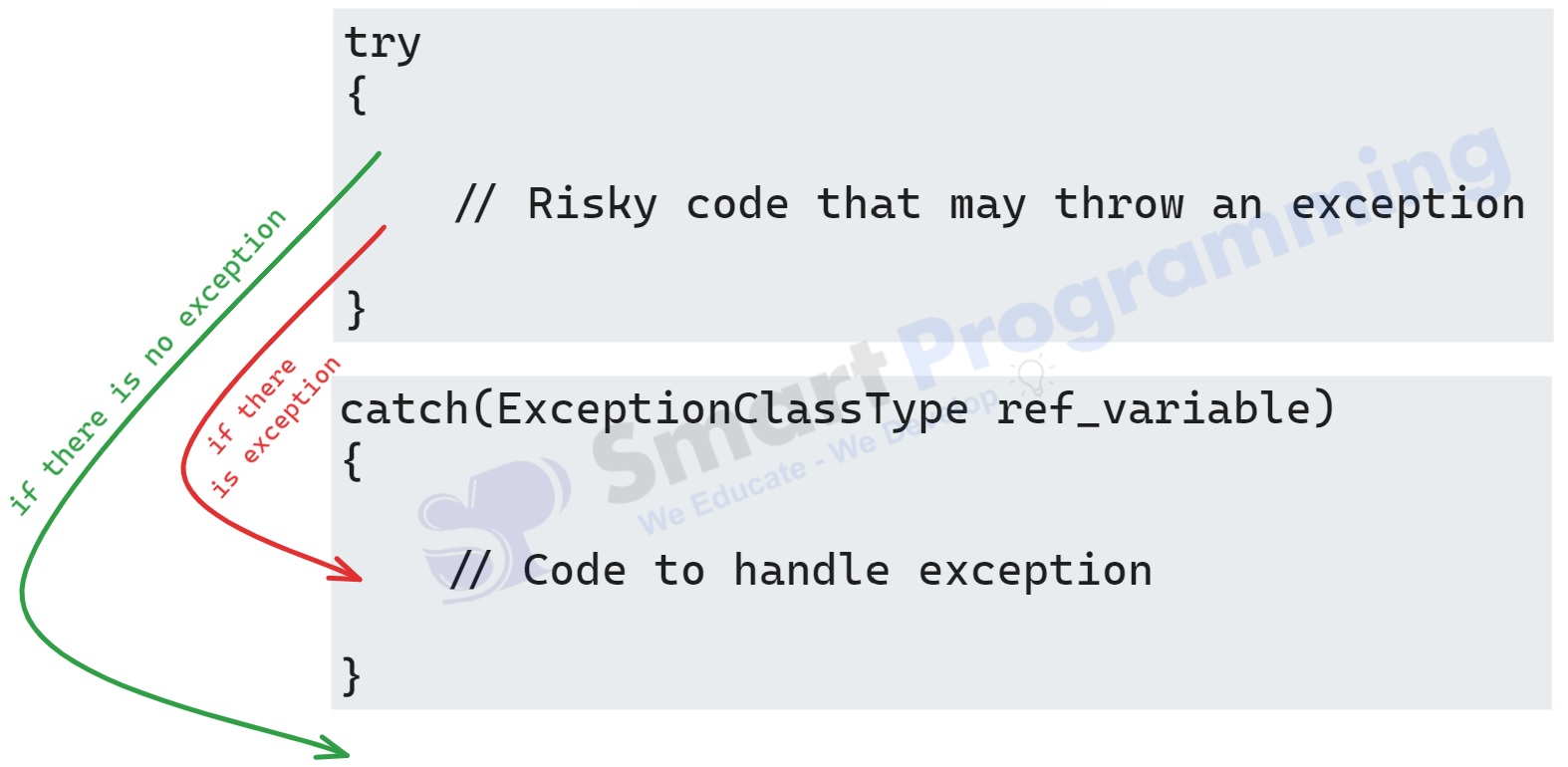try-catch Block in Java
Introduction
-
Definition:
-
tryandcatchare blocks in Java used for exception handling. - They allow developers to handle runtime exceptions gracefully without crashing the program.
-
-
tryblock:-
tryblock contains the code that may throw an exception. - In simple words we can say, it contains the risky code that can cause an exception.
-
Syntax:
try { // Risky code that may throw an exception }
-
-
catchblock:-
catchblock is used to handle the exception thrown by thetryblock. -
In simple words we can say, it contains the code that will handle the exception if it occurs in
tryblock. -
Syntax:
catch(ExceptionClassType ref_variable) { // Code to handle exception }
-
-
Example:
- Lets take an example in which we will take two numbers as input from the user and divide them.
-
First we will create program without using
try-catchblock. -
import java.util.Scanner; public class MainApp1 { public static void main(String[] args) { System.out.println("----- App Started -----"); Scanner sc = new Scanner(System.in); System.out.println("Enter no 1"); int no1 = sc.nextInt(); System.out.println("Enter no 2"); int no2 = sc.nextInt(); int res = no1 / no2; System.out.println("Result : "+res); System.out.println("----- App Finished Successfully -----"); } }Output 1:
----- App Started ----- Enter no 1 100 Enter no 2 4 Result : 25 ----- App Finished Successfully -----
Output 2 (If user provides no2 = 0):
----- App Started ----- Enter no 1 100 Enter no 2 0 Exception in thread "main" java.lang.ArithmeticException: / by zero at MainApp1.main(MainApp1.java:17) -
If the user enters 0 as the second number, it will throw an
ArithmeticExceptionand the program will terminate abnormally.-
----- App Finished Successfully -----will not be printed as the program is terminated abnormally.
-
-
Now we will modify the above program to handle the exception using
try-catchblock. -
import java.util.Scanner; public class MainApp1 { public static void main(String[] args) { System.out.println("----- App Started -----"); Scanner sc = new Scanner(System.in); try { System.out.println("Enter no 1"); int no1 = sc.nextInt(); System.out.println("Enter no 2"); int no2 = sc.nextInt(); int res = no1 / no2; System.out.println("Result : "+res); } catch(ArithmeticException ae) { System.out.println("Exception Occured : "+ae); } System.out.println("----- App Finished Successfully -----"); } }Output 1:
----- App Started ----- Enter no 1 100 Enter no 2 4 Result : 25 ----- App Finished Successfully -----
Output 2 (If user provides no2 = 0):
----- App Started ----- Enter no 1 100 Enter no 2 0 Exception Occured : java.lang.ArithmeticException: / by zero ----- App Finished Successfully -----
-
Here, we have wrapped the risky code inside the
tryblock and handled theArithmeticExceptionin thecatchblock. -
Now, if the user enters 0 as the second number, it will throw an
ArithmeticException, but instead of terminating the program abnormally, it will jump to thecatchblock and print the exception message.
Points to remember for try-catch block:
-
trycannot be used alone; it must be followed bycatchorfinally.-
Syntax :
try { // Risky code that may throw an exception } catch(ExceptionClassType ref_variable) { // Code to handle exception }try { // Risky code that may throw an exception } catch(ExceptionClassType ref_variable) { // Code to handle exception } finally { // Code that will always execute (explained later) }
-
Syntax :
-
The exception object (i.e., the reference variable in the
catchblock) contains detailed information about the exception, such as the :- exception class name
- message / description
- stack trace
-
If an exception occurs in
tryblock, then only program jumps to thecatchblock, but if there is not exception intryblock, thencatchblock is skipped or will not be executed.
Different ways to print exception object:
-
Using
getMessage()- Prints only the exception message.
-
catch (Exception e) { System.out.println(e.getMessage()); }
-
Using
toString()- Prints the exception class name along with the message.
-
catch (Exception e) { System.out.println(e.toString()); }
-
Using
printStackTrace()- Prints full stack trace including the line number where the exception occurred.
-
catch (Exception e) { e.printStackTrace(); }
Tip: Use
printStackTrace() for debugging and getMessage() or toString() for user-friendly messages.
Help Us Get Better Every Day
Your feedback helps us grow! If there's anything we can fix or improve, please let us know.
We’re here to make our tutorials better based on your thoughts and suggestions.



